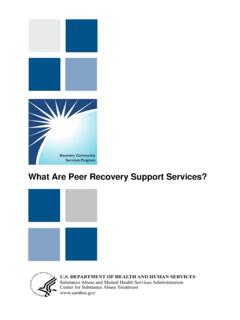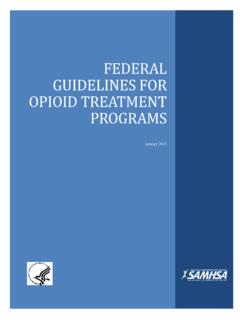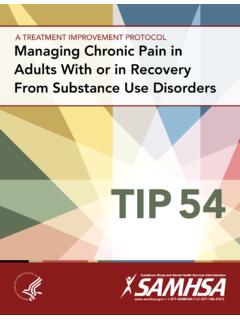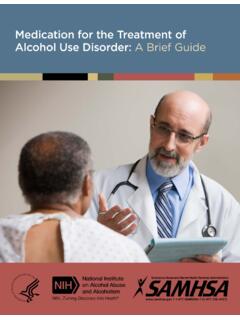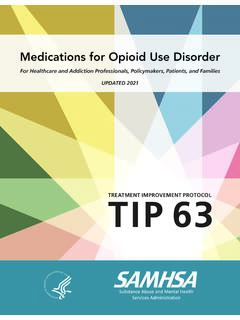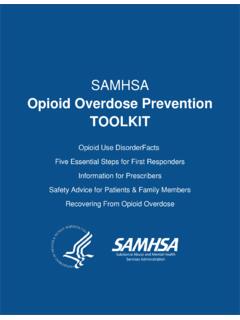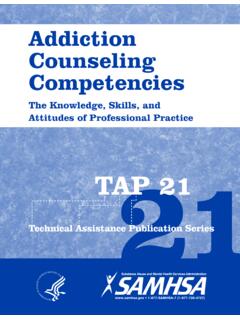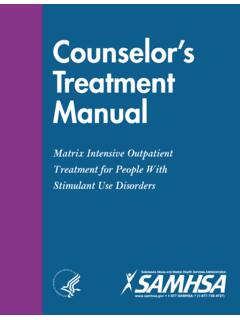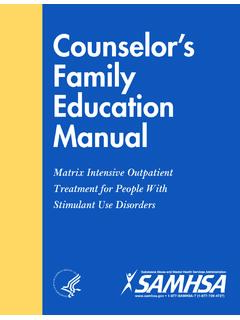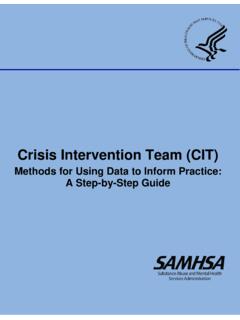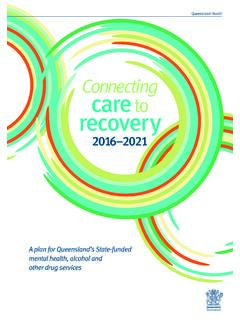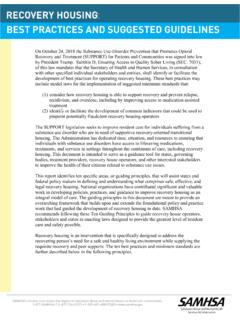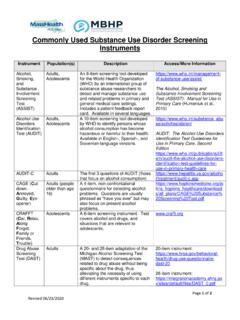Transcription of Substance Use Disorders Recovery with a Focus on ...
1 EVIDENCE-BASED RESOURCE GUIDE SERIES Substance Use Disorders Recovery with a Focus on Employment and Education Substance Use Disorders Recovery with a Focus on Employment and Education Acknowledgments This report was prepared for the Substance Abuse and Mental Health Services Administration (SAMHSA) under contract number HHSS2832017000651I/HHSS28342001T with SAMHSA, Department of Health and Human Services (HHS). Thomas Clarke served as contracting officer representative. Disclaimer The views, opinions, and content of this publication are those of the authors and do not necessarily reflect the views, opinions, or policies of SAMHSA or HHS. Nothing in this document constitutes a direct or indirect endorsement by SAMHSA or HHS of any non-federal entity s products, services, or policies, and any reference to non-federal entity s products, services, or policies should not be construed as such.
2 Public Domain Notice All material appearing in this publication is in the public domain and may be reproduced or copied without permission from SAMHSA. Citation of the source is appreciated. However, this publication may not be reproduced or distributed for a fee without the specific, written authorization of the Office of Communications, SAMHSA, HHS. Electronic Access This publication may be downloaded from Recommended Citation Substance Abuse and Mental Health Services Administration: Substance Use Disorders Recovery with a Focus on Employment and Education. HHS Publication No. PEP21-PL -Guide-6 Rockville, MD: National Mental Health and Substance Use Policy Laboratory. Substance Abuse and Mental Health Services Administration, 2021. Originating Office National Mental Health and Substance Use Policy Laboratory, Substance Abuse and Mental Health Services Administration, 5600 Fishers Lane, Rockville, MD 20857, HHS Publication No. PEP21-PL -Guide-6.
3 Nondiscrimination Notice SAMHSA complies with applicable federal civil rights laws and does not discriminate on the basis of race, color, national origin, age, disability, or sex. SAMHSA cumple con las leyes federales de derechos civiles aplicables y no discrimina por motivos de raza, color, nacionalidad, ni edad. Substance Use Disorders Recovery with a Focus on Employment and Education Acknowledgements I Evidence-Based Resource Guide Series Overview The Substance Abuse and Mental Health Services Administration (SAMHSA), and specifically, the National Mental Health and Substance Use Policy Laboratory, is pleased to fulfill the charge of the 21st Century Cures Act to disseminate information on evidence-based practices (EBPs) and service delivery models to prevent Substance misuse and help individuals with Substance use Disorders (SUD), serious mental illnesses (SMI), and serious emotional disturbances (SED) get the treatment and support that they need.
4 An important Focus for SAMHSA is supporting sustained Recovery from SUD through the use of employment mechanisms. This guide reviews the literature and science; examines best practices; identifies key components of peer-reviewed models that affect policies and programs; and identifies challenges and gaps in implementation. Individuals in treatment and Recovery can vary in many ways. They experience different mental health and Substance use conditions; may have co-occurring Disorders ; live in diverse parts of the country; and/or may experience a variety of socio-economic factors that can help or hinder Recovery . All these factors can complicate evaluating the effectiveness of SUD services, treatments, and supports. But despite these variations, there is evidence to support that appropriate programming may reduce SUD, lessen mental health symptoms, and improve quality of life. The Evidence-Based Resource Guide Series is a comprehensive and modular set of resources intended to support health care providers, health care system administrators, and community members meet the needs of individuals at risk for, experiencing, or recovering from SUD, SMI, and SED.
5 Each guide is developed with input from expert panels made up of federal, state, and non-governmental participants. These panels provide input based on their knowledge of health care systems, implementation science, EBPs, provision of services, and policies that foster change. Panels include a unique group of accomplished scientists, providers, and administrators from provider and community organizations, federal and state agencies as well as persons with lived experience. Research shows that implementing EBPs requires a multipronged approach. This guide is one piece of an overall approach to implement and sustain change. Users of these guides are encouraged to review the SAMHSA Website for additional tools and technical assistance opportunities. 1 Substance Use Disorders Recovery with a Focus on Employment and Education Evidence-Based Resource Guide Series Overview Content of the Guide This guide contains a foreword and five chapters.
6 The chapters are m odular and do not need to be read in order. Each chapter is designed to be brief and accessible to SUD and other health care providers, health care system administrators, community members, and others working to meet the needs of individuals at risk for, experiencing, or recovering from SUD. FW Evidence-Based Resource Guide Series Overview Introduction to the series. 1 Issue Brief Overview of the topic, the importance of the issue, challenges, approaches for providing employment supports, and policy considerations. 2 What Research Tells Us An evidence review of the effectiveness of employment supports for individuals experiencing SUD. 3 Elements that Improve Program Effectiveness Examples of programs and program elements that improve supported employment program effectiveness. 4 Guidance for Selecting and Implementing Evidence-Based Practices and Programs Practical information to consider when selecting and implementing employment programs.
7 5 Resources for Quality Improvement and Evaluation Guidance and resources for performance monitoring, process evaluation and monitoring outcomes for the purpose of quality improvement. Focus OF THE GUIDE Sustained Recovery from SUD is si gnificantly tied t o meaningful and purposeful work -life balance. Employment is a n important factor for achieving sustained Recovery and financial independence. This guide provides an overview of issues, ch allenges, policies, an d practices related to employment for i ndividuals in Recovery . It su mmarizes the state of the science through an evidence review of the known effectiveness of programs providing employment supports to i ndividuals with SUD. Finally, the guide provides expert panel consensus recommendations of key program elements to support individuals with employment-related Recovery . Substance Use Disorders Recovery with a Focus on Employment and Education Evidence-Based Resource Guide Series Overview 2 Substance Use Disorders Recovery with a Focus on Employment and Education Issue Brief The purpose of this guide is to provide an overview of issues, challenges, policies, and practices related to employment and workforce training for individuals in Recovery from a Substance use disorder (SUD).
8 SUD occurs when an individual s continuous drug or alcohol misuse leads to clinically significant impairment."1 Symptoms can include severe health problems, disability, and a failure to meet responsibilities at work, school, or SUD impacts individuals, families, and communities by contributing to a loss in productivity, greater incidence of criminal justice involvement, and an increased burden on the health care The 2019 National Survey on drug Use and Health (NSDUH) shows that million individuals 12 and older experienced SUDs and more than million have both a SUD and mental Additionally, more than million people in the United States suffered from an opioid use disorder (OUD) related to prescription opioids, and over 260,000 had an OUD related to Illicit drug use also accounted for $49 billion in reduced participation in the Prescription opioid misuse alone accounted for an estimated $ billion in lost employment or reduced Recovery from SUD can be a difficult, but achievable Recent research indicates that sustained Recovery is significantly tied to meaningful and purposeful work-life , 8 Employment is an important element for sustaining Recovery and maintaining financial independence.
9 Issue Brief 3 Employment is reported as a top life priority by people in all stages of These individuals often can and want to work regardless of where they are in the Recovery process. Work is one of the best predictors of positive outcomes for individuals with SUD. Individuals who are employed compared to those unemployed are more likely to demonstrate:13, 15, 16 Lower rates of recurrence Higher rates of abstinence Less criminal activity Fewer parole violations Improvements in quality of life More successful transition from long-term residential treatment back to the community. A longitudinal study of Government Performance and Results Act (GPRA) survey data indicated that clients who are employed while in treatment are significantly more likely to successfully complete treatment than unemployed Regardless of whether work is paid or volunteer, individuals who work are more likely to reduce their Substance use18-20 and better able to maintain Key Definitions Substance Use Disorder: Recurrent use of alcohol and/or drugs causing clinically significant impairment such as health-related problems and/or an inability to meet daily responsibilities at work, school, or Recovery : A process of change through which individuals improve their health and wellness, live self-directed lives, and strive to reach their full Work: Purposeful activity that produces something of economic or social value such as goods or Supported Employment.
10 Programs that support competitive employment based on worker preferences with ongoing individualized services for persons with the most severe Abstinence-Enforced Employment Supports: Programs aimed at promoting abstinence and lifestyle changes with competitive employment as a secondary goal. Clients are required to pass alcohol and/or drug screening to participate in work and may receive other behavioral incentives. Education Supports: A range of supportive services provided al ong with employment services that help individuals consider and pursue the training needed to achieve their work goals. Substance Use Disorders Recovery with a Focus on Employment and Education 4 Issue Brief Challenges to Obtaining Employment A number of potential barriers to employment may exist for persons with SUD such as:7, 22-25 Lack of job skills/lower education attainment Poor work history Poor interpersonal skills/motivation to work Lack of transportation Lack of childcare Lack of identification such as a birth certificate, driver s license Continued Substance misuse/recurrence Criminal history Employer lack of understanding about SUD Scheduling conflicts with probation and treatment requirements Policy Considerations Recovery -Friendly Employment Policies Peer Support and Peer- Recovery Specialists/Navigators Recent estimates indicate that close to half of employed individuals who are engaged in private SUD treatment are in Many employers have long understood the value of peer support and personal experience as a strength for employees.
